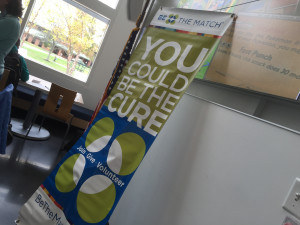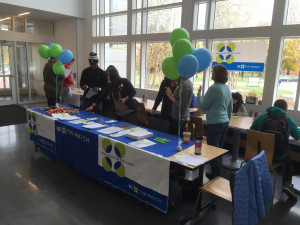Finding a match, saving a life
Whether you realize it or not, you hold the power of saving a life in your very hands, or more literally, in your bone marrow.
Each year, more than 20,000 people in the United States are diagnosed with life-threatening illnesses that leave bone marrow transplant as one of the best treatment options and thanks to a registry drive at SUNY Poly this fall, the chances of finding a perfect match will hopefully increase.
The bone marrow transplant replaces a patient’s diseased blood-forming cells with healthy cells, but it’s a well-matched donor that is they key to a successful transplant. When looking for a successful match, doctors search for a marrow donor with a human leukocyte antigen (HLA) tissue type that closely matches that of the patient in need. HLA are proteins that act as markers for the immune system to recognize the cells that belong in the body and those that do not.
Because tissue type is inherited, you might expect that a family member would be the best match. However, only 30% of patients will have a relative who matches and is able to donate. The other 70%, or roughly 14,000 people, need volunteers willing to donate their healthy marrow.
Be the Match Registry prides itself on being “the largest and most diverse donor registry in the world,” connecting patients searching for a cure and life-saving bone marrow donors and on October 25, representatives from Be the Match were at SUNY Poly’s Utica campus in the hopes of expanding that registry with even more donors and more chances at saving lives.

Be the Match Registry prides itself on being “the largest and most diverse donor registry in the world,” connecting patients searching for a cure and life-saving bone marrow donors.
“With 14,000 people waiting for a match, even though there are roughly 28 million people in the registry, finding the right match can be like trying to find a needle in a haystack,” said Betty House, a Be the Match volunteer at the registry drive. “The reason we go to college campuses is because there are so many young, healthy people on campuses. And the turnover helps increase the amount of donors too. Students register, they graduate and move on, new students come in and register, etc.”
House has some personal experience with Be the match, who found her brother a bone marrow donor. She says that today, he is healthy and back to work as a physician’s assistant thanks to the transplant match that was found for him via Be the Match.
The process students and other participants underwent that day to become part of the bone marrow donor registry was quite simple. They filled out a questionnaire regarding their background and health, then had their cheek swabbed.
“After that,” House says. “If they’re a match, they answer the call.”
Recent Comments
Archives
- September 2018
- August 2018
- May 2018
- April 2018
- March 2018
- February 2018
- January 2018
- December 2017
- November 2017
- October 2017
- September 2017
- May 2017
- April 2017
- March 2017
- February 2017
- January 2017
- December 2016
- November 2016
- October 2016
- September 2016
- August 2016
- May 2016
- April 2016
- March 2016
- February 2016
- January 2016
- December 2015
- November 2015
- October 2015
- September 2015
- August 2015
- May 2015
- April 2015
- March 2015
- February 2015
- January 2015
- December 2014
- November 2014
- October 2014
- September 2014
- August 2014
- May 2014
- April 2014
- March 2014
- February 2014
- January 2014
- December 2013
- November 2013
- October 2013
- September 2013
- August 2013
- June 2013
- May 2013
- April 2013
- March 2013
- February 2013
- January 2013
- December 2012
- November 2012

